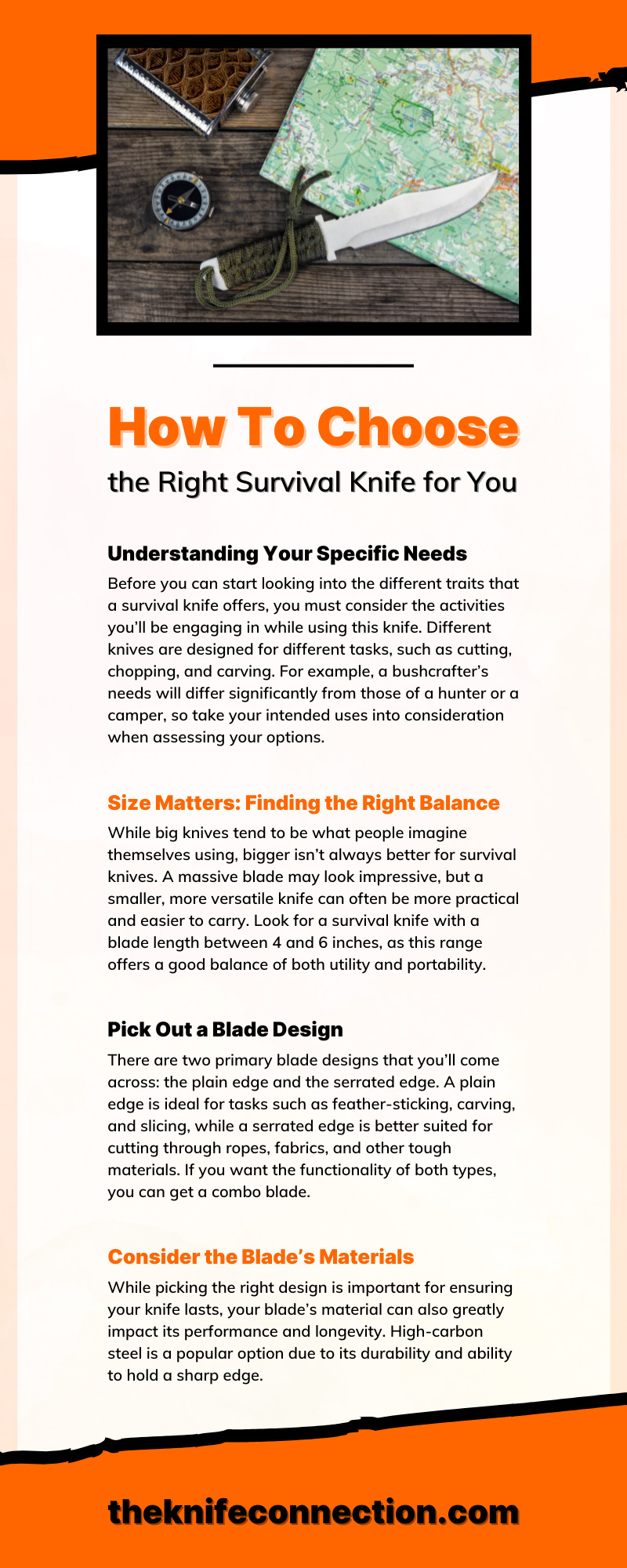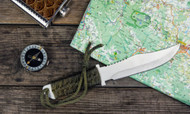How To Choose the Right Survival Knife for You
Sep 5 2023 - 10:46
There’s nothing quite as great as spending the weekend in the great outdoors. You can’t beat the beautiful views and the smell of the fresh air out there. However, it’s not all fun and games. When out in the wild, you need the right tools to take care of yourself.
One of the best things you can bring with you is a survival knife. If you don’t already have one, you’ll need to take the time to find the one that works best for you. In this guide, we’ll go over everything you need to know to choose the right survival knife for you. That way, you can be ready for any task or problem that comes your way while enjoying the wilderness.
Understanding Your Specific Needs
Before you can start looking into the different traits that a survival knife offers, you must consider the activities you’ll be engaging in while using this knife. Different knives are designed for different tasks, such as cutting, chopping, and carving. For example, a bushcrafter’s needs will differ significantly from those of a hunter or a camper, so take your intended uses into consideration when assessing your options.
Size Matters: Finding the Right Balance
Let’s start this guide by looking at the size of your knife. While big knives tend to be what people imagine themselves using, bigger isn’t always better for survival knives. A massive blade may look impressive, but a smaller, more versatile knife can often be more practical and easier to carry. Look for a survival knife with a blade length between 4 and 6 inches, as this range offers a good balance of both utility and portability.
Pick Out a Blade Design
There are two primary blade designs that you’ll come across: the plain edge and the serrated edge. A plain edge is ideal for tasks such as feather-sticking, carving, and slicing, while a serrated edge is better suited for cutting through ropes, fabrics, and other tough materials. If you want the functionality of both types, you can get a combo blade.
Consider the Blade’s Materials
While picking the right design is important for ensuring your knife lasts, your blade’s material can also greatly impact its performance and longevity. High-carbon steel is a popular option due to its durability and ability to hold a sharp edge. Stainless steel is more resistant to rust and corrosion, but you may need to sharpen it more frequently. There are plenty of other options, but these two are the most popular for a reason.
Handle Comfort and Grip
The blade means nothing without the right handle to accompany it. An ergonomic handle is crucial since it can significantly impact your ability to manipulate your survival knife effectively. Choose a knife with a handle that fits comfortably in your hand and provides a secure grip. Handles made of a durable material, like G-10, Micarta, or Kraton, are usually the best since they are resistant to general wear and tear and environmental factors.
The Tang: Full or Partial?
The tang of a knife refers to the part of the blade that extends into the handle. In survival situations, a full-tang knife is typically the better option. With a full tang, the knife is one solid piece, and the handle is usually two pieces that are attached to the blade, one on each side. This makes the knife stronger and less likely to break, providing greater durability. Partial tangs may not withstand hard use, as they are not fully integrated into the handle, posing a risk of the blade and handle separating.
Fixed Blade vs. Folding Knife
Since full tangs are the better choice for survival knives, fixed-blade carry knives are usually a great option. They will be able to provide the stability and durability necessary for heavy-duty tasks, such as batoning wood or prying. While a folding knife may be convenient since you can safely fold it up for storage purposes, it won’t be as strong for general usage. For a true survival knife, a fixed blade is the way to go.
The Sheath: More Than Just a Cover
To store your knife safely, you’ll want to get a sheath for it. The sheath of your survival knife plays a pivotal role in how you carry and access it. A good sheath should fit your knife securely and provide convenient carry options.
Many sheaths come with belt loops or clips, while others may offer a lanyard hole for neck carry. Consider the material, too; leather sheaths are classic and durable, while Kydex or nylon sheaths are lighter and more resistant to environmental conditions.
Price vs. Quality: Making the Right Investment
Finally, consider the balance between the price and quality of the survival knife. While opting for a low-cost option is tempting to save some money, remember that a survival knife is an investment. Higher-priced knives often use superior materials and construction methods that ensure longevity and reliable performance. Keep your budget in mind while shopping, but also remember that buying a cheap knife may lead to more costs in the long run if it breaks or needs frequent replacement.
Final Thoughts: Trust Your Instincts
There’s no one-size-fits-all solution for choosing the right survival knife for your needs. As you navigate the array of options, remember that the best survival knife for you depends heavily on your personal needs, preferences, and intended uses. Trust your instincts and choose a knife that feels right in your hand and suits your lifestyle.
After all, this could be the tool that makes a difference when you find yourself in a survival situation. Research well, compare different brands, and don’t hesitate to seek expert opinion if needed. The right choice of a survival knife can serve you faithfully for many years, making it a worthwhile investment.
Now that you have the tools and knowledge to make an informed decision on the perfect survival knife, it’s time to start exploring your options. Don’t forget to check out the many options we have available on our site. While not every knife will be the perfect survival knife, they all have their advantages, and all our knives are of the best quality.

